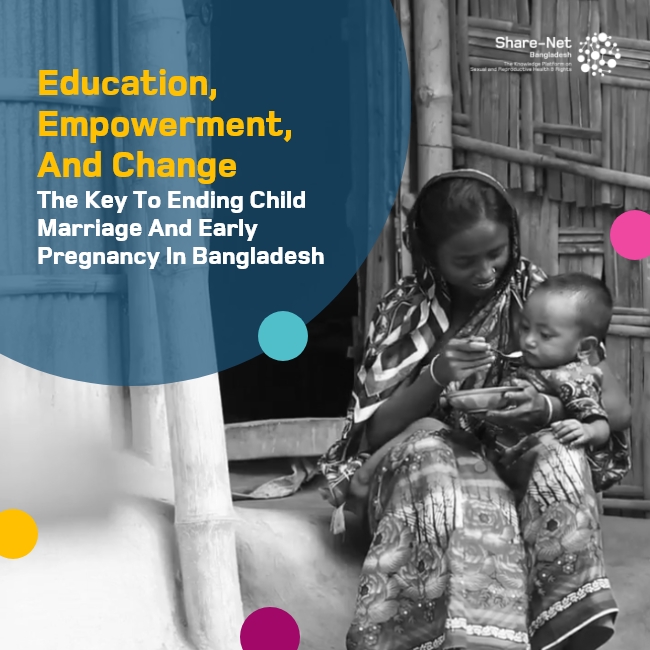Education, Empowerment, and Change: The Key to Ending Child Marriage and Early Pregnancy in Bangladesh
“Bangladesh has a much higher rate of childbirth before age 18 compared to neighbouring countries,” reports UNICEF. With 24.2% of births occurring before 18, the situation in Bangladesh surpasses that of Afghanistan (20.4%), Nepal (13.8%), India (8.3%), and Pakistan (7.4%). This alarming statistic underscores the urgent need to address adolescent sexual and reproductive health and rights (SRHR) in the country.
The Bangladesh Bureau of Statistics (BBS) further reveals that over 25% of pregnancies occur among adolescents aged 15-19. This high rate of early pregnancy is closely linked to the prevalence of child marriage. The 2023 BBS Sample Vital Statistics show that 41.6% of women aged 20-24 were married before 18, and the rate of marriages before age 15 rose from 6.5% to 8.2% from 2022 to 2023. These figures highlight the pressing need to tackle child marriage to improve SRHR outcomes.
Despite the introduction of the 2017 Child Marriage Restraint Act, which aimed to replace outdated legislation, loopholes allowing marriages under 18 in “special circumstances” remain. Coupled with the socioeconomic impacts of the Covid-19 pandemic, these legal exceptions have contributed to the persistence and rise of child marriages, particularly in rural areas where the rate surged to 44.4%.
Addressing adolescent childbearing in Bangladesh requires a multi-pronged approach that involves stricter enforcement of existing laws, education, community engagement, and improved access to reproductive health services. The Child Marriage Restraint Act needs stringent enforcement, with no exceptions, to ensure marriages occur only after legal adulthood.
Education plays a critical role in delaying marriage and early pregnancy. Investing in girls’ education empowers them with knowledge about reproductive health, reduces their likelihood of early marriage, and increases their economic opportunities. Educated girls are better equipped to make informed choices about their bodies and futures, contributing to a reduction in adolescent pregnancies.
Community education campaigns are essential to raise awareness about the negative consequences of child marriage and early pregnancy. Engaging community leaders, religious figures, and healthcare providers can help shift social norms and challenge traditional beliefs that perpetuate child marriage.
Access to family planning services and reproductive health information is vital. Providing adolescent girls with contraception and counselling on sexual and reproductive health empowers them to make informed decisions. These services must be readily available and accessible, especially in rural areas where the need is greatest.
Poverty is a significant driver of child marriage. Improving economic opportunities for families can reduce the pressure to marry off young daughters. Programs that enhance economic prospects for young women, such as vocational training and financial literacy, can further reduce their vulnerability to child marriage.
Engaging men and boys in discussions about child marriage and adolescent pregnancy is also crucial. Promoting gender equality and healthy relationships can create a supportive environment for girls and contribute to long-term societal change.
Addressing adolescent childbearing in Bangladesh is not just a public health concern but also a critical issue for achieving the Sustainable Development Goals (SDGs). Ensuring good health and well-being (SDG 3), quality education (SDG 4), and gender equality (SDG 5) are interlinked with the efforts to reduce adolescent pregnancies and child marriage.
Bangladesh’s fight against adolescent childbearing requires a sustained commitment from the government, civil society, international agencies, and communities. By implementing a comprehensive approach that tackles the root causes and empowers young women, Bangladesh can pave the way for a healthier, more prosperous, and equitable society.
Source: The Business Standard
Source Contributor: Dr Matiur Rahman, Researcher and development worker
Picture Credit:

